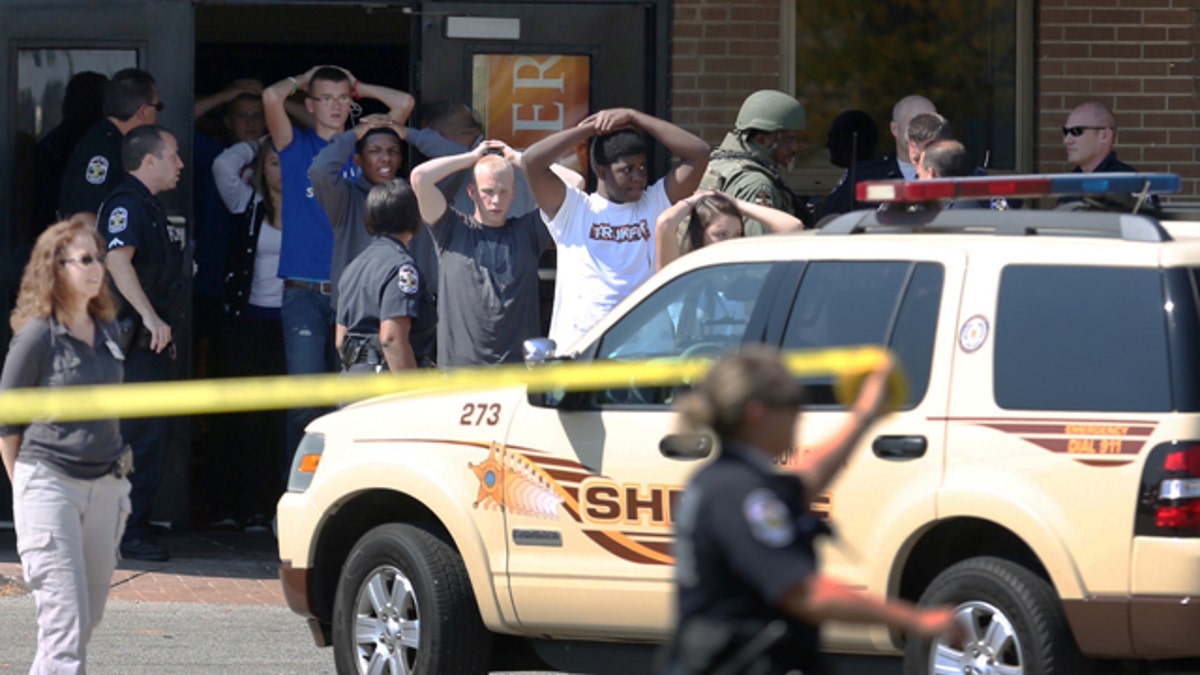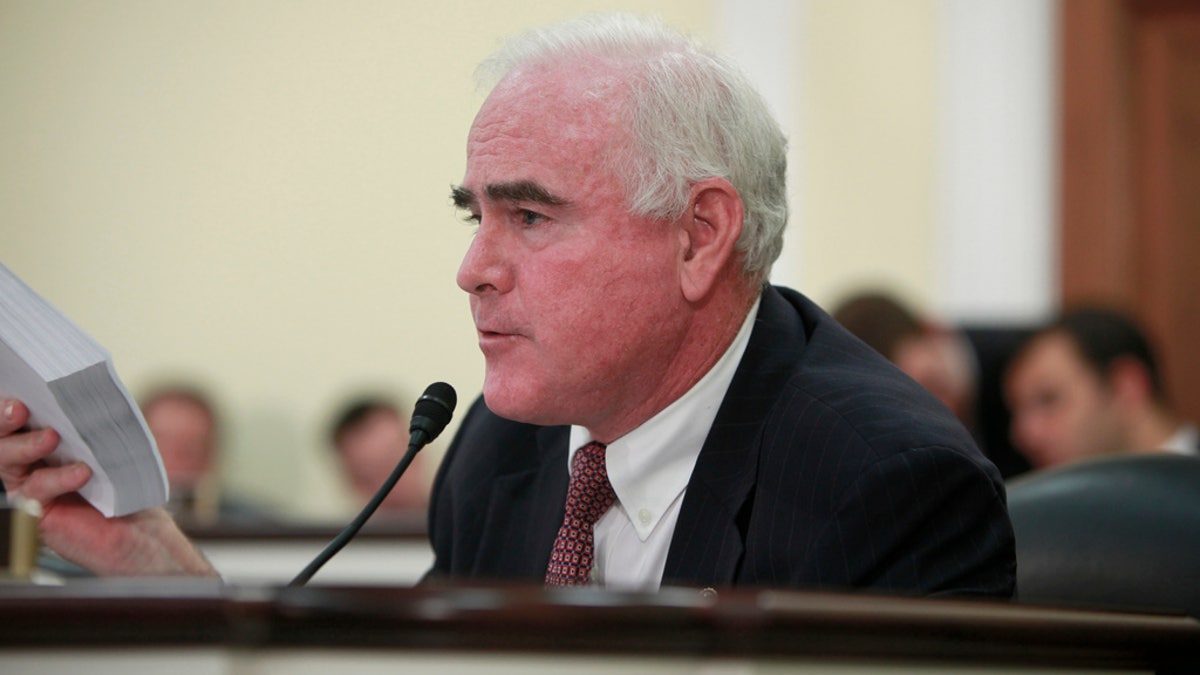
September 30, 2014: Students put their hands on their heads as they are led out of Fern Creek High School in Louisville, Ky. (AP Photo/The Courier-Journal, Scott Utterback)
The calls – and the fear that followed – spread quickly the morning of Jan. 19.
In Pennsylvania, officials were told a bomb would explode within 45 minutes at a Chichester school. In Delaware, a shooter was reported on the roof of a school building. In Massachusetts, a caller said a bomb hidden in a backpack at Arlington High School would explode – then a shooter would massacre fleeing students.
By the time the menacing calls finally subsided, more than 50 schools in at least 10 states had been affected.
The response varied greatly by district. In some, administrators influenced by ever-expanding rumors on social media and scores of worried parents, evacuated schools and canceled classes. Other school district officials, sensing a lack of credibility in the threat, did nothing.
The approaches mirrored the coastal differences last month when identical terror threats were emailed regarding schools in Los Angeles and New York. LA, still on edge following the recent San Bernardino terror attack two weeks before, closed public schools. New York, with typical bravado, kept schools open.
In December, and again on Jan. 19, the results were the same: No bombs or shooters were ever found.
“We did not know at the time,” Chichester Superintendent Kathleen Sherman told Philly.com. “We just needed to make sure our students were safe.”
SWATing
"School administrators are responding not to the credibility of the threat, they’re responding to the pressure, the community anxiety.”
In the aftermath of the multi-state frenzy, several schools said the messages they received were strikingly similar. When asked if the threats were linked, Teaneck Police Chief Robert Carney told NorthJersey.com, “If they’re not, it’s a heck of a coincidence.”
Investigators traced the calls to Bakersfield, Calif., though, to date, no suspects have been identified.
“Apparently this is coming through recycled, computer-generated numbers,” Bergen County Sheriff Michael Saudino told Pix11.
The practice has a name: SWATing.
The moniker comes from the SWAT team responses that sometimes accompany the threatening calls. The exercise has its roots in the online gaming community, according to school safety expert Kenneth Trump. Some disgruntled players would use the ip address of an adversary to contact authorities, alleging a crime. Cops would then bust into a house expecting to find a man with a gun, or a similarly dangerous person. Instead, they’d be greeted by the shocked target of a gamer’s derision.
SWATing also affected those outside the gaming community and has more recently spread to schools on a mass level.
“These threats are coming from a variety of ways,” Trump told FoxNews.com. “One is when they lose a game they have to SWAT ‘x’ number of locations. There’s also SWATing done as part of the game. The more you SWAT, the more points you get.”
Tough choices
SWATing forces school administrators to make a tough choice: In most cases they have a high degree of certainty the threat is fake… but what if it isn’t?
“It’s one of those things where you’re gonna be damned if you do and damned if you don’t,” said Ed Dorff, executive director of The Wisconsin School Safety Coordinators Association. “You balance the concern for safety with whether or not this disruption is going to be worthwhile or not.”
And there’s another pressure that administrators must consider.
“The social media buzz spikes about the threats in the community. Parents, traditional media outlets, anxiety from students and staff starts to build. Parents show up on the doorsteps,” Trump said. “And school administrators are responding not to the credibility of the threat, they’re responding to the pressure, the community anxiety.”
He added: “They’re responding more emotionally to the politics of the school community. And when you respond emotionally instead of to the credibility, you risk doing something that can actually put kids in a less safe situation.”
Trump directed a study by the National School Safety and Security Services of 812 school threats across the country in 2014, from Aug. 1 to Dec. 31. Almost 30 percent of the threats involved a school evacuation and about 10 percent resulted in a school closing for at least one day.
Some officials have refused to give in to the temptation to be overly cautious in the face of a non-credible threat.
“Dismissal/evacuation was not warranted, and if done when not needed, rewards threatening behavior and encourages more threats,” Billerica, Mass. district officials tweeted Jan. 19.
But few blame officials who choose to evacuate.

Rep. Patrick Meehan, R-Pa., has introduced the Interstate Swatting Hoax Act. (meehan.house.gov)
“I am challenged by trying to give the right kind of advice in that situation,” Rep. Patrick Meehan, R-Pa., told FoxNews.com. Meehan, a former prosecutor and U.S. attorney, has had SWATing incidents in his district.
“I think there is tremendous pressure on an administration, absent some clear indication that this is a hoax, to try and do the prudent thing in the circumstance,” he said. “There isn’t a lot of time to contemplate it. It has to be made on a moment’s notice.”
Trump has some advice for school officials: plan ahead.
He preaches the wisdom of gaming out threats ahead of time, having a threat assessment team and a crisis management communications protocol.
“School officials need to treat every threat seriously, but doing so does not automatically equate to an evacuation or school closure,” Trump said. “By having threat assessment teams, training or protocol in place, schools officials are better equipped to be able to hit the ground running.”
Feds stepping in
Part of the allure for school SWATer is the difficulty in tracking down the culprits.
One issue is there is little motive evident. A perpetrator rarely has ties to schools affected.
“Something that wide spread, somebody just looking to disrupt things,” Dorff said. “Some warped sense of ‘Hey, look what I was able to do.’ They’re probably just a step removed from people who actually commit acts of violence.”
But Trump said while the offenders may believe they’re anonymous, law enforcement is “starting to get more tech savvy.”
Congress is also starting to get involved.
Meehan and Rep. Katherine Clark, D-Mass., recently introduced the Interstate Swatting Hoax Act and Meehan is currently working to get co-sponsors for the bill, which would make SWATing a federal crime.
“The purpose is to fill a gap which currently exists in the inability to appropriately prosecute these cases under federal law,” Meehan said. “The nature of communications has changed and frequently these kind of threats are being channeled through communications systems and can be channeled through states far away, and it makes it difficult for a local community that’s been affected to not only do an investigation, but also get support and collaboration from the community where the crime originated.”
The FBI doesn’t have those issues, Meehan said.
In the meantime, local police leadership is confident in catching the person – or people – behind the Jan. 19 spree.
“When we catch the people doing this,” Bergen County Sheriff Michael Saudino told NorthJersey.com, “an example’s going to be made.”

